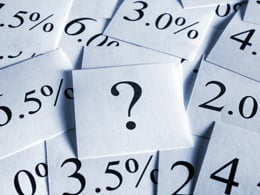 I am at the Commonwealth Leaders Conference this week, at one of the most beautiful properties I have ever seen. So, of course, I am sitting in a conference room listening to economic presentations. But I’m okay with that.
I am at the Commonwealth Leaders Conference this week, at one of the most beautiful properties I have ever seen. So, of course, I am sitting in a conference room listening to economic presentations. But I’m okay with that.
One of the great things about conferences like this one is that they offer the opportunity to listen to a group of sponsors present some of their most compelling investing ideas. I heard a very interesting point this morning that I’ve noted previously but not paid sufficient attention to: The return from bonds (in aggregate) is almost always very close to the initial yield. In other words, if the average yield is around 6 percent, you can expect a return of approximately 6 percent over time, subject to a bunch of qualifications, of course.
This makes sense if you think about it. With a bond, you get the coupon payments, and you get your money back. Your return should be the initial yield if you hold to maturity and have no defaults.
What this means in the present day, though, is that bonds are not all the different from cash. The current yield, at just over 2 percent, is not that compelling. If past patterns hold, an investor can expect a return, over time, of about 2 percent for a diversified bond portfolio. This is much less than we’ve seen historically.
In the mid-1990s, for example, CD rates were around 5 percent. In the mid-2000s, they were around 4 percent. A 2-percent bond return is simply not that good in this context.
Does this mean we should not invest in bonds? Certainly not! What it does mean, though, is that we need to consider:
- The role of bonds in portfolios
- What bonds mean for portfolio returns overall
Why we have bonds in our portfolios
Historically, the gap between likely stock and bond returns was not nearly as wide as it is today. Bonds were in a portfolio for diversification and risk reduction—but also because they were expected to be a meaningful contributor to the total portfolio return. They pulled their weight when it came to the bottom line. Nowadays, the risk reduction is certainly there but the return contribution much less so.
What bonds mean for portfolio returns
Let’s quantify this. If bonds were yielding (and therefore expected to return) around 6 percent, then with a 40-percent allocation you would expect bonds to account for about 2.4 percent of the portfolio’s total return. If, on the other hand, bonds were, in aggregate, yielding around 2 percent (which they are today), that same 40-percent allocation would yield an expected return of 1.2 percent under the same assumptions. That drop of 1.2 percent in the total portfolio return is meaningful and should be addressed.
I have written quite a bit about how the stock market is priced at a level where future returns—over 5 to 10 years—are very likely to be below expectations. This morning’s conference presentation brought home to me that I should be doing the same analysis for the bond market. Arguably, the bond market is even more overpriced than the stock market. That doesn’t mean a correction is imminent—for either market—but it is something that we should be aware of.
As always, the question is: What can we do about it? Stay tuned to this blog for more of my thoughts on how to factor in an overpriced bond market.


 Print
Print


